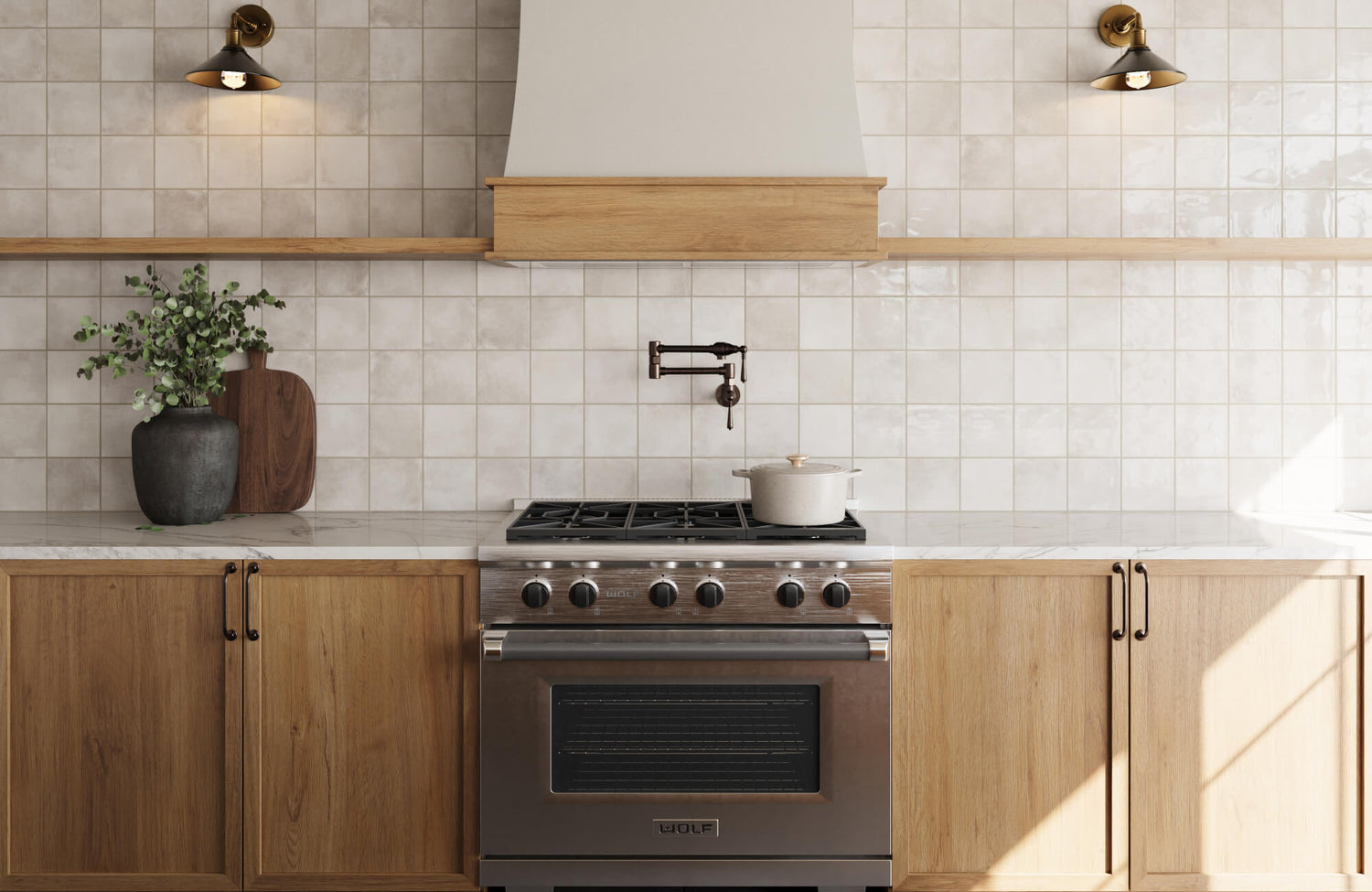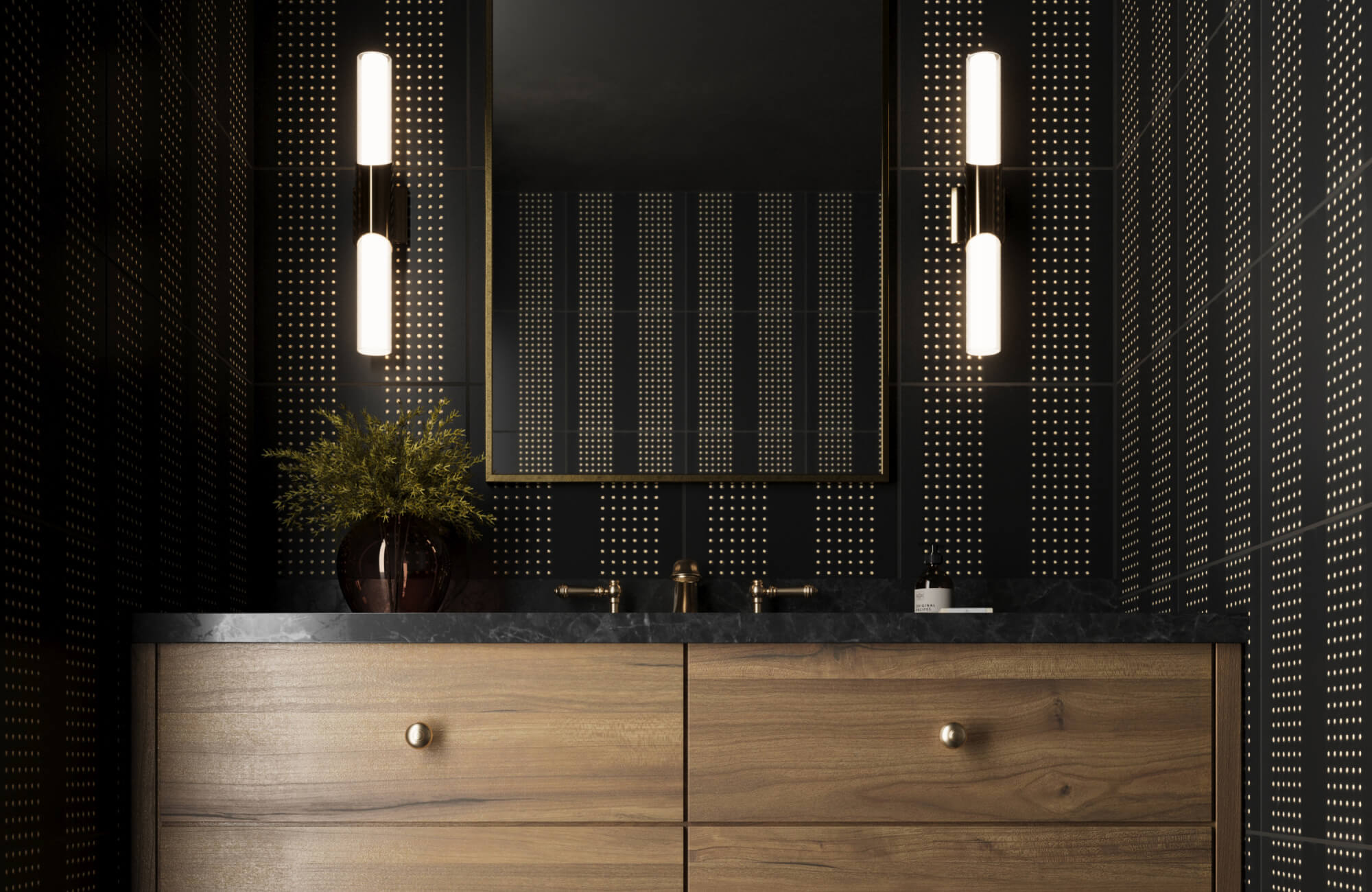Ceramic backsplashes are a stylish and practical choice for any home, but keeping them looking their best starts with the right cleaner. Whether your tile is glossy, matte, textured, or wood-look, each finish reacts differently to certain products. Using the wrong formula can lead to residue, fading, or even damage over time.
In this guide, we’ll help you choose a cleaner that’s safe, effective, and suited to your specific tile type. From exploring finishes to tackling common stains, you’ll find everything you need to keep your ceramic backsplash fresh, protected, and easy to maintain, no matter the color or style.

Exploring Your Ceramic Tile Type
Not all ceramic tiles are created the same, so before reaching for a cleaner, it helps to know what you're working with. Finishes like glossy, matte, textured, or wood-look each react differently to moisture, residue, and scrubbing methods. For example, a glazed tile (which has a protective coating) is usually more resistant to staining and easier to wipe down, while unglazed or textured surfaces may need gentler cleaners and more attention to prevent buildup. Identifying your tile’s finish is the first step to cleaning it safely and effectively.
If you’re not sure what type of finish your ceramic backsplash has, try looking at how it reflects light or feels under your fingers. Glossy tiles will have a smooth, shiny surface, while matte or textured tiles, such as our Dani 1.6x5 Matte Ceramic Tile in Cream above, can feel more natural or slightly rough. Wood-look ceramics may mimic the feel of real grain and usually require a bit more care to preserve their design detail. It’s also worth noting that ceramic tiles are generally softer and more porous than porcelain, which means they’re a bit more sensitive to harsh cleaning agents, so being extra cautious goes a long way.
What Makes a Cleaner Safe for Ceramic Backsplash Use
When it comes to cleaning ceramic backsplashes, not every product is a good match. Using the wrong solution can dull the finish, damage the grout, or leave behind residue. Below are a few key qualities that help you spot a cleaner that’s safe for both your tile and your kitchen environment.
pH-Neutral Formulas
pH-neutral cleaners are gentle enough to protect the finish of your ceramic tile while still being effective against everyday messes. Unlike acidic or alkaline options, they won’t wear down glazed surfaces or strip protective coatings. They're also safer on grout, helping to prevent discoloration or crumbling over time. This makes them a great everyday go-to for kitchens where food splatters and light stains are common.
Non-Abrasive Ingredients
Avoid cleaners with gritty particles or harsh scrubbing agents, especially on glossy or decorative tile surfaces. These can cause tiny scratches that dull the shine or damage colored finishes. Instead, look for liquid or gel formulas labeled "non-abrasive"; they lift dirt without relying on physical friction. Soft microfiber cloths or sponges also work well alongside these solutions for gentle but effective cleaning.
Kitchen-Safe & Grout-Friendly Labels
Cleaners labeled as "safe for kitchen surfaces" or "grout-safe" give an added layer of reassurance. These products are often tested for use around food prep zones and sealed tile edges, so you know they won’t introduce harsh fumes or residues. Some will even specify if they’re safe for ceramic, making your decision easier. Choosing cleaners with these specific labels helps protect not just the tile but the overall integrity of your backsplash area.
Common Stains on Ceramic Backsplashes
Ceramic backsplashes stand up well to daily messes, but certain stains need a more targeted approach. Grease, acidic food splatters, and mineral buildup are all common culprits in kitchens, and each interacts with your tile differently. Below, we break down how to safely tackle these stains based on where and how they show up, especially on colored or textured ceramic tiles.
Grease and Cooking Oil
Grease stains are some of the most stubborn, especially on darker ceramic tiles like brown or black. They tend to cling to the tile surface and build up over time, creating a film that’s tough to remove with water alone. Start with a soft microfiber cloth and warm dish soap to break up fresh grease. For deeper buildup, a degreasing spray made for ceramic surfaces can lift oils without damaging the finish.
Avoid abrasive scrubbing pads or overly strong cleaners, as they can dull the glaze or scratch textured tiles. Instead, go for a product labeled non-abrasive and safe for glazed or colored tile. Degreasing wipes are also a good option for quick cleanups between deeper cleaning sessions. A consistent weekly wipe-down can go a long way in keeping grease from becoming a long-term problem.
Tomato Sauce and Food Splatters
Tomato sauce and other food splatters are common around stovetops and prep zones, and can be especially noticeable on white or blue ceramic tiles. These stains are acidic and often leave a visible ring or dull mark if not cleaned quickly. Use a soft sponge with a pH-neutral cleaner to gently scrub away fresh food splashes. For dried stains, a paste of baking soda and water can help lift the discoloration without harming the tile’s surface.
Avoid using straight vinegar or lemon juice, especially on darker or matte-finished tiles, as it may cause uneven fading or surface wear. Always test new cleaning methods on a small area first. If you're working with a patterned or colored backsplash, rinsing thoroughly and drying the area can also prevent streaking. Spot cleaning regularly keeps stains from setting and helps preserve the crisp look of your ceramic tile.
Hard Water and Mineral Stains
Hard water stains often form around sinks, faucets, or any tile exposed to splashing and air-drying. These mineral deposits can leave a chalky white film that dulls the tile’s surface, especially on glossy or light-colored finishes. To prevent buildup, dry the area with a soft cloth after use or during your daily wipe-down. When stains appear, use a gentle descaling cleaner specifically labeled for ceramic tile.
Stay away from full-strength vinegar or lemon-based cleaners unless heavily diluted, as they can weaken grout or etch the tile surface over time. A non-scratch sponge or microfiber cloth works best for lifting mineral residue without leaving marks. For ongoing maintenance, using a rinse-free cleaner and avoiding hard-bristled brushes will help keep both tile and grout in great shape. Regular attention in these water-prone spots keeps your backsplash looking bright and clean.
How to Match Cleaners to Your Ceramic Tile Color
The color of your ceramic backsplash isn’t just a design decision, it also affects how easily stains and residue show up. Dark and light tiles come with different maintenance needs, so choosing a cleaner that works well with your tile’s hue can make everyday care much simpler.
Dark Tiles (Black, Navy, Brown)
Darker ceramic tiles are rich and dramatic, as seen above with our Mikayla 5x5 Glossy Ceramic Tile in Espresso, but they tend to reveal water spots, grease smudges, and cleaner streaks more quickly. That’s why low-residue or rinse-free cleaners are best for these finishes, especially if they have a glossy surface. It also helps to use a microfiber cloth after cleaning to prevent streaking or film buildup that can dull the surface.
When cleaning darker tiles, avoid anything overly acidic or abrasive, as it may wear down the glaze over time. Stick to pH-neutral solutions that maintain shine without stripping the finish. If your tiles are near the stove or sink, you might want to clean more frequently to keep buildup from becoming more noticeable.
Light Tiles (White, Cream, Gray)
Lighter ceramic tiles, like our Jaden 2.5x16 Glossy Ceramic Tile in Eggshell, can give off a clean, airy feel, but they’re also more likely to show food splatter, soap residue, and even water spots, especially in cooking areas. Choosing a gentle, clear cleaner can help avoid haze and keep white or light-gray tiles looking crisp. Always rinse thoroughly and dry the surface afterwards to prevent any film from setting in.
These tiles also tend to highlight any missed spots, so regular touch-ups between deep cleans are helpful. If you're dealing with hard water, consider wiping surfaces down with a microfiber cloth or using distilled water to reduce spotting. With the right care, your lighter backsplash will stay bright without the constant battle against dulling or discoloration.
Avoiding Damage to Grout and Tile
Grout might seem tough, but it’s actually one of the most delicate parts of a ceramic backsplash. Without proper care, it can crack, crumble, or discolor, especially when exposed to strong chemicals or rough tools. That’s why it’s best to stick with grout-safe, pH-neutral cleaners and gentle tools like microfiber cloths or soft-bristled brushes. These help remove buildup without disturbing the grout lines or the edges of the tiles.
Avoid using metal scrubbers, harsh acids, or undiluted bleach, which can erode grout and dull the surrounding ceramic. If you're tackling minor staining, a baking soda paste gently applied with a damp sponge can lift residue without harming the surface. Always check your product label to confirm it's safe for use on both tile and grout; many general-purpose cleaners aren’t ideal for these more detailed areas.
After cleaning, be sure to dry the backsplash thoroughly to prevent lingering moisture from seeping into the grout. This small step helps reduce the chance of mildew and keeps both the grout and tile in better condition over time. With consistent, gentle care, your backsplash will stay clean, polished, and structurally sound.
When to Use a Specialty Tile Cleaner
For everyday messes, a gentle, all-purpose, ceramic-safe cleaner will often do the trick. But there are times when a specialty tile cleaner is worth the extra step, especially if you’re dealing with a high-gloss backsplash that shows smudges or a textured tile that traps grease. These specialty formulas are designed to lift stubborn stains without damaging the tile’s finish or the surrounding grout. Look for labels that specify use on ceramic surfaces and match your tile’s particular needs, whether it’s shine retention, residue removal, or deep cleaning.
You might also want to invest in a specialty cleaner if your backsplash has seen long-term buildup or discoloration that basic products just can’t remove. For instance, a degreasing spray formulated for kitchen tiles can safely break through layers of oil without scrubbing too harshly. Just be sure to follow all instructions carefully and test any new cleaner on a small, hidden area first. When used thoughtfully, these products can refresh your backsplash and extend the life of your tile without the risk of damage.
Keep Your Ceramic Backsplash Looking Its Best
Taking care of your ceramic backsplash doesn’t have to be complicated; it just takes a little knowledge and the right approach. Understanding your tile’s finish and color helps you avoid the guesswork when picking a cleaner, especially when dealing with common stains like grease or hard water. Whether your tile is glossy white, rich brown, or wood-look ceramic, the key is using gentle, tile-safe products that preserve both surface and grout.
By matching your cleaner to your backsplash’s specific needs, you protect the beauty and durability of your space over time. Don’t be afraid to explore specialized or natural options when the situation calls for it. If you're ever unsure, our team is here to help you choose the best solution. With the right care, a bit of confidence, and a free sample in hand to guide your decision, your ceramic backsplash can stay looking fresh and stylish for years to come.







